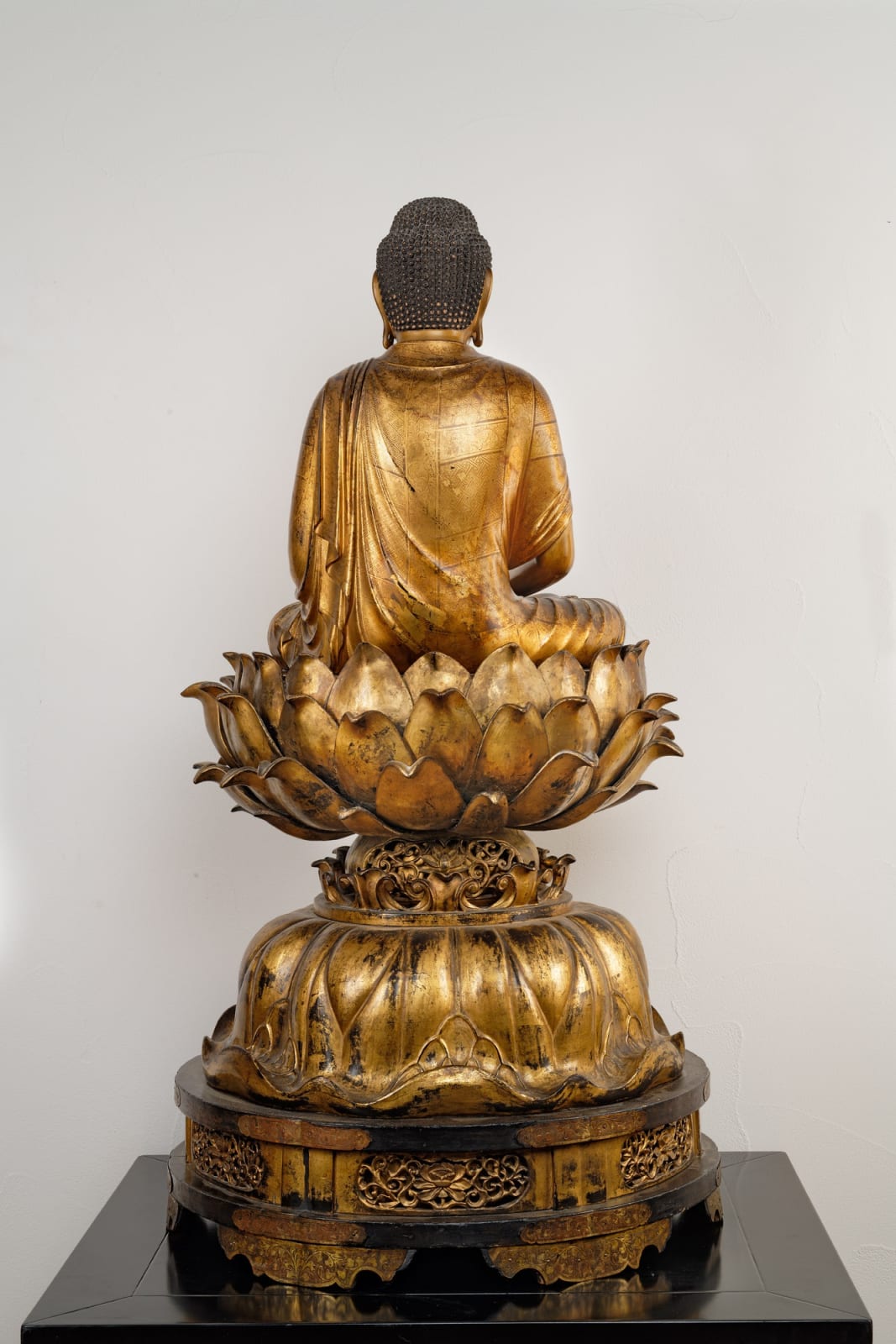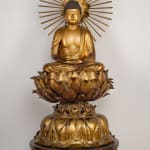Unknown
A very fine Japanese Edo period lacquered and gilded wooden sculpture of Amida Buddha, showing the Buddhist deity seated cross legged in deep meditation. His face with closed eyes under delicately arched brows, has a serene expression, his dark hair is arranged in rows of coils that also cover the ushnisha, the protuberance on the head. The pendulous earlobes are pierced and on the forehead between the eyebrows the third eye of spiritual vision is visible. The Buddha, with a bare chest, wears a thin monk’s robe that falls in elegant pleats around his shoulders and wraps itself around his knees and legs, with his hands linked together in between the exposed soles of his feet. With a radiating burst of light centred by a lotus flower fixed to the back, the Buddha is seated on a finely carved lotus with three tiers of upward facing petals on an inverted domed lotus with flattened back and a circular base
Japan, early nineteenth century
Height of the Buddha 54 cm, width of the Buddha 42 cm. Overall height 140 cm.
Buddhism, which was introduced to Japan in the sixth century AD, flourished under the patronage of the imperial prince Shōtoku (574–622) and the establishment of the great temples of Hōryū-ji, close to present-day Nara and Shitennō-ji in Osaka. Early forms of Buddhism, arriving from China and Korea, were chiefly those of Mahayana or Esoteric Buddhist practices that emphasised a concept of universal salvation via the worshiping of a complex assortment of deities and elaborate rituals. Even though Mahayana Buddhism remains an element within present day Japanese religious life, by the end of the tenth century it had begun to give way to the more accessible and popular practice, known as Pure Land Buddhism.
Pure Land Buddhist worship centred on the Amida Buddha (Amitabha or Amida Nyorai), also known as or the Buddha of Immeasurable Light and Buddha of Limitless Life. Amida officiated over a heavenly paradise and promised salvation and rebirth in his paradise for all worshippers. Works of art were essential to the Pure Land doctrine and its emphasis on rebirth and salvation in the next-world. Meditation encouraged practitioners to visualise Amida in his heavenly paradise and accumulate religious merit through simple meditation and recitation of prayers or sutras. Until the twelfth century Amida Buddha was typically represented seated on a lotus flower. However, during the Heian (794–1185) and Kamakura (1185–1333) periods the concept of raigō (welcoming descent) flourished and thus Amida Buddha was often shown in a standing pose descending from the heavens to fetch his devotees and personally transport them back to his blissful paradise.
As is evident, the present nineteenth century Amida Buddha is shown seated in deep concentration with half-closed eyes and hands held together in his lap in the gesture of meditation. He wears a simple monk’s robe, draped over the shoulders, leaving his chest and the lower part of one arm exposed. His hair arrangement, typical for Amida, is composed of hundreds of curls, and raised at the top in a cranial bulge which is one of the marks of the Buddha’s supernatural powers. The present figure is similar to a seated Amida Buddha from the Heian period (794–1185) in the Asian Art Museum, San Francisco. Its size suggests that it was used in a temple or for an altar of a high standing family.



